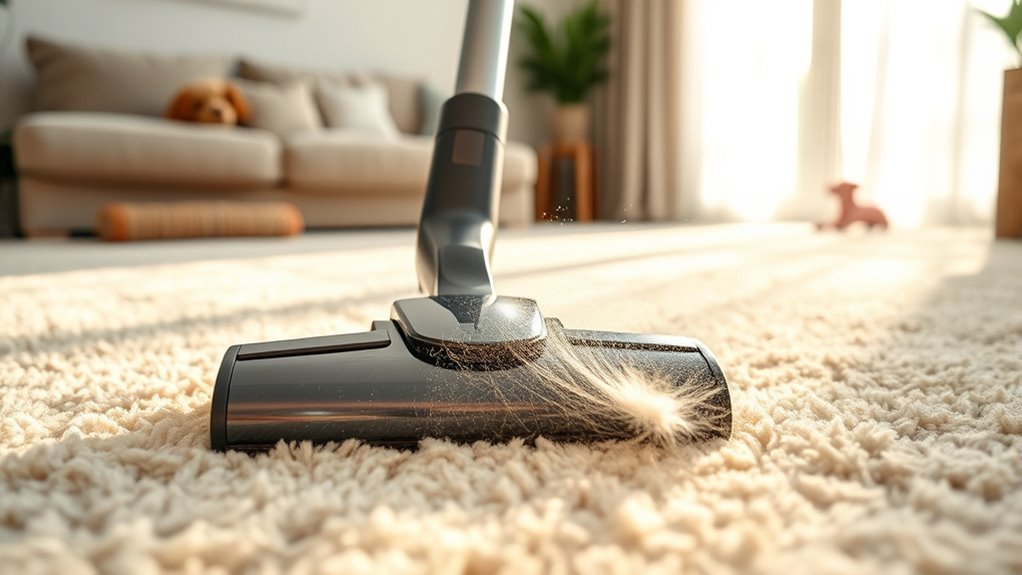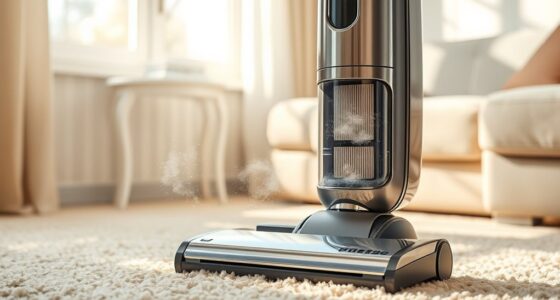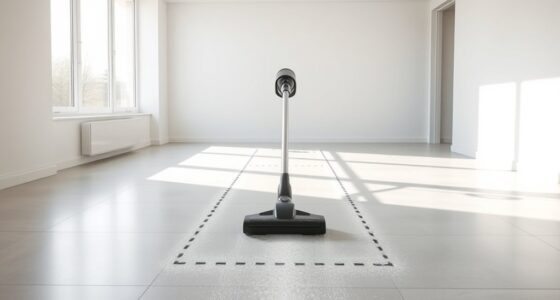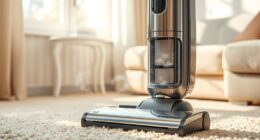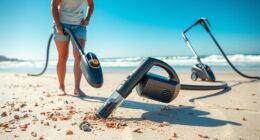To drastically reduce pet allergy flare-ups, use a vacuum with a HEPA filter and a sealed system to trap allergens effectively. Move slowly and systematically across carpets and upholstery, overlapping passes for thorough cleaning. Vacuum high-traffic areas and pet sleeping spots 3-4 times weekly, especially during shedding season. Regularly clean filters, bags, and brushes. For more effective techniques and tips to keep allergens low, keep exploring these strategies.
Key Takeaways
- Use a vacuum with HEPA filters and a sealed system to trap and contain pet allergens effectively.
- Vacuum slowly with overlapping passes to thoroughly dislodge and lift pet dander from surfaces.
- Focus on high-traffic areas, furniture, pet beds, and under furniture for targeted allergen removal.
- Maintain proper posture and follow a systematic cleaning pattern to ensure complete coverage.
- Vacuum regularly (3–4 times weekly), especially after grooming or during shedding seasons, to minimize allergen buildup.
Choosing the Right Vacuum Cleaner for Allergies
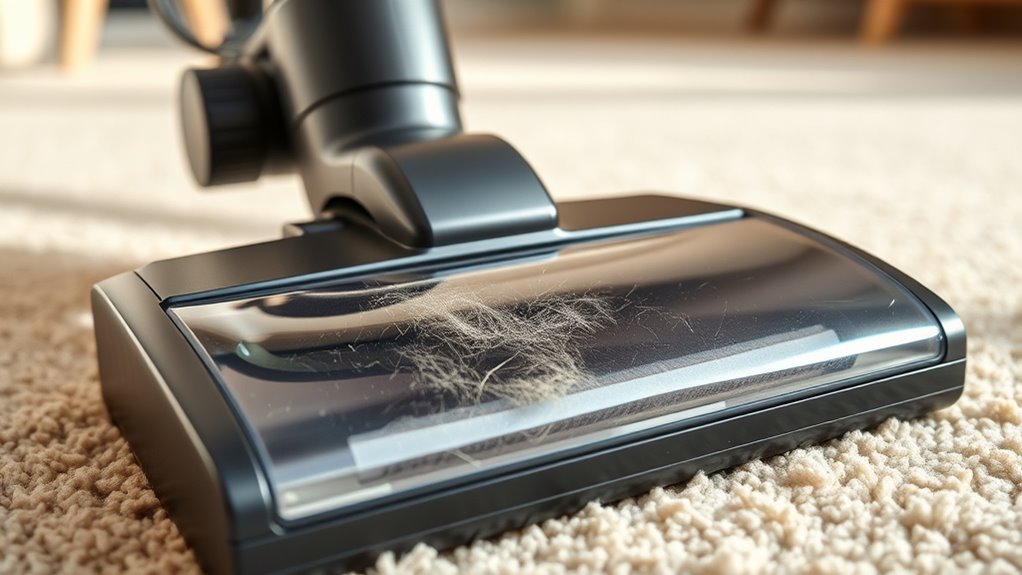
When selecting a vacuum cleaner to manage pet allergies, it’s essential to look for models designed to trap allergens effectively. Consider the types of vacuum bags; HEPA bags are best because they seal in tiny particles and prevent allergen escape. You also need to decide between cordless and corded vacuums. Corded models typically offer more consistent power, making them ideal for deep cleaning, while cordless vacuums provide portability and ease of use for quick cleanups. Both types can be effective, but confirm they have sealed systems that prevent pet dander from escaping. A vacuum with the right bag type and power source helps reduce allergen circulation, making your environment safer and more comfortable for allergy sufferers. Additionally, understanding home environment dynamics can help you choose the most effective cleaning strategies for allergy control.
Using HEPA Filters to Capture Pet Dander Effectively
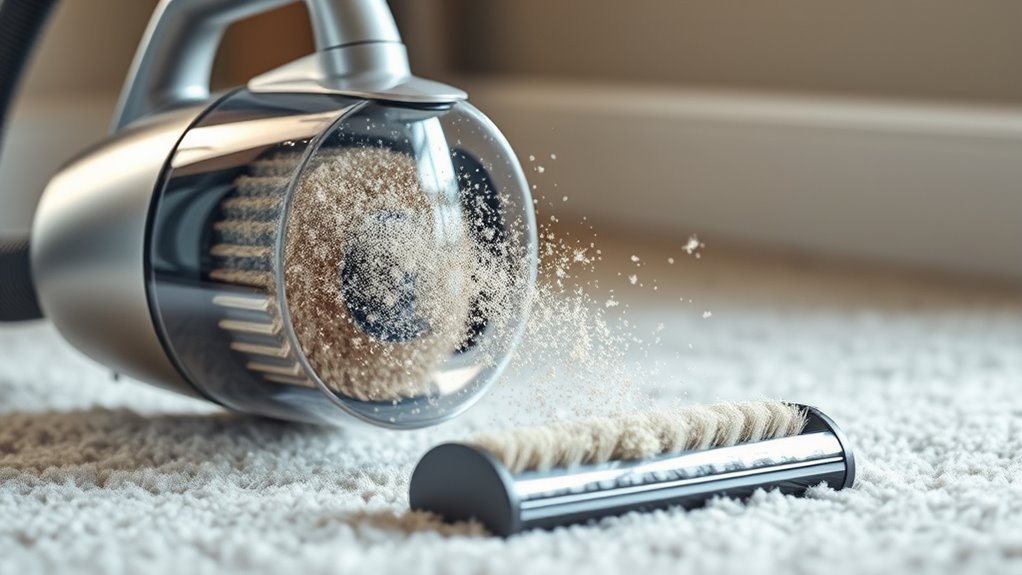
Have you considered how HEPA filters can greatly improve your ability to capture pet dander? These filters are designed for pet dander filtration, trapping tiny particles that trigger allergies. To maintain their effectiveness, regular HEPA filter maintenance is essential—clean or replace filters as recommended by the manufacturer. When your vacuum uses a HEPA filter, it ensures that allergens don’t get recirculated into the air. This considerably reduces pet dander in your home, providing relief during allergy flare-ups. Remember, a well-maintained HEPA filter maximizes pet dander filtration efficiency, making every vacuuming session more effective. Incorporating a vacuum with a HEPA filter into your routine is a simple yet powerful step toward creating a healthier environment for allergy sufferers. Robotics integration is also being explored to further improve cleaning efficiency and allergen removal.
Vacuuming Frequency and Scheduling for Maximum Impact
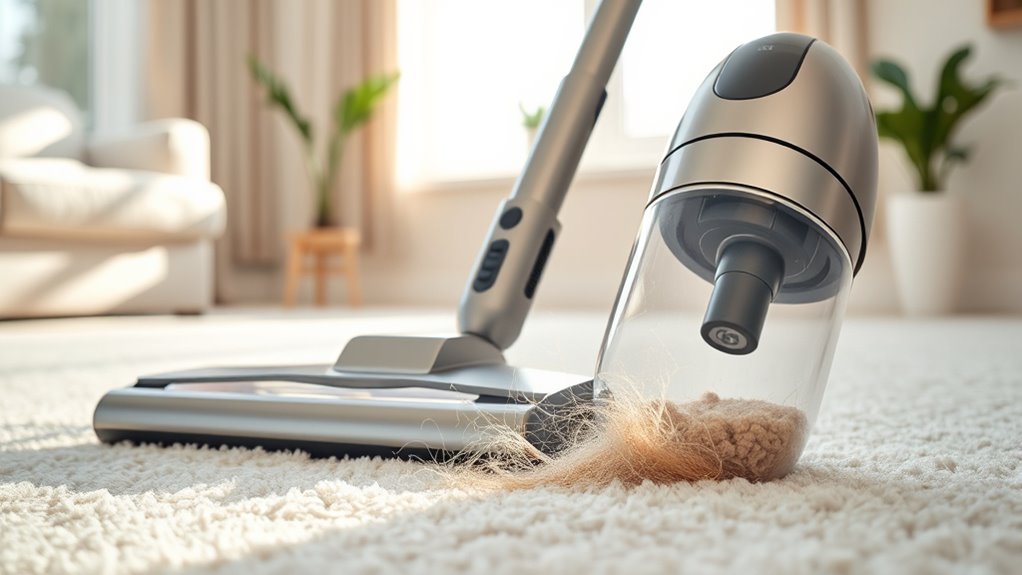
To keep pet dander under control, you need a consistent vacuuming schedule. Cleaning often enough prevents buildup, but too frequent vacuuming can be unnecessary and tiring. Find the right timing that fits your home, and you’ll see a real difference in allergy symptoms. Regular vacuuming with effective filtration systems can further reduce airborne allergens and improve indoor air quality.
Regular Vacuuming Schedule
Establishing a consistent vacuuming schedule is essential for minimizing pet allergy flare-ups. You should aim to vacuum at least two to three times a week to remove pet dander, hair, and allergens effectively. Sticking to a regular routine helps prevent allergen buildup, making pet allergy management more effective. Keep high-traffic areas, furniture, and carpets on your vacuuming list, since these spots trap the most allergens. Use a vacuum with a HEPA filter to trap microscopic particles and improve air quality. Incorporating emotional support strategies can help manage the frustration that sometimes accompanies ongoing cleaning routines. Consistency is key; sporadic cleaning won’t cut it. By maintaining a regular vacuuming schedule, you’ll reduce allergen levels and create a healthier environment for everyone, especially those sensitive to pet allergens. This proactive approach makes a noticeable difference in controlling allergy symptoms.
Optimal Cleaning Frequency
For maximum effectiveness in reducing pet allergens, setting the right cleaning frequency is essential. Vacuuming too infrequently allows allergen buildup and pet hair to accumulate, worsening symptoms. Ideally, you should vacuum high-traffic areas at least 3–4 times a week, and less-used spaces twice a week. This schedule minimizes allergen buildup and keeps pet hair removal consistent. To help you plan, consider this guideline:
| Room Type | Vacuuming Frequency | Focus Area |
|---|---|---|
| Living Room | 3–4 times/week | Pet hair removal |
| Bedroom | 2–3 times/week | Allergen buildup |
| Closet/Storage | Weekly | Pet hair and dust |
Adjust based on your pet’s shedding and allergy severity for maximum impact. Regular vacuuming with a high-efficiency filter further enhances allergen control and air quality.
Timing for Allergy Control
Timing your vacuuming sessions strategically can considerably reduce pet allergy flare-ups. To maximize allergy control, schedule vacuuming around your pet’s grooming routines and allergy medication schedules. Consider these tips:
- Vacuum at least twice a week, especially after pet grooming sessions when dander is most active.
- Increase frequency during shedding seasons to prevent dander buildup.
- Vacuum before allergy medications take effect, so airborne allergens are minimized when medications peak.
- Time deep cleaning on weekends or days off for thorough dust and pet hair removal, reducing flare-ups during the week.
- Incorporate air purifiers into your home environment to further reduce airborne allergens and support your vacuuming efforts.
Proper Techniques for Vacuuming Carpets and Upholstery
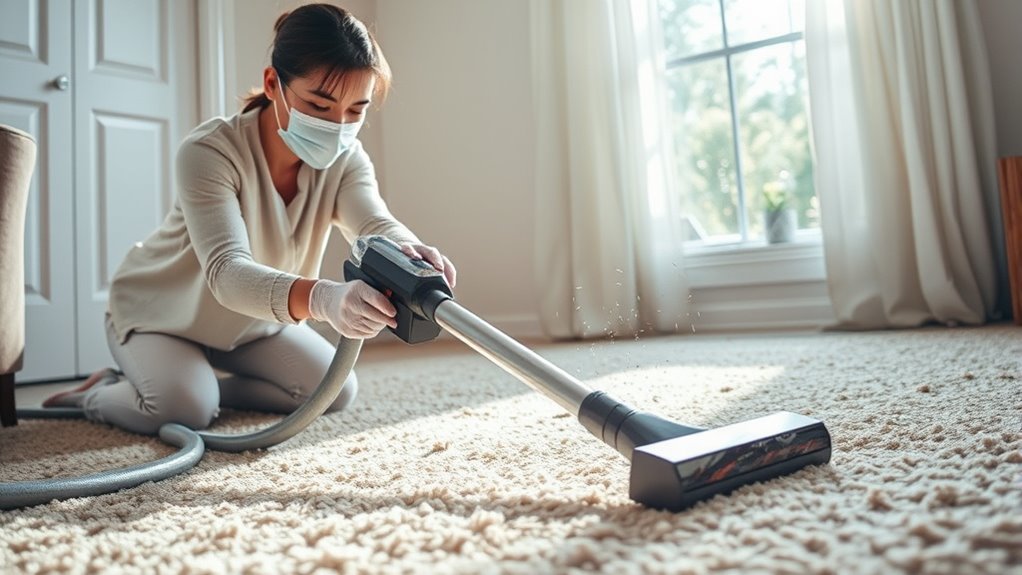
To effectively diminish pet allergens, use your HEPA filter vacuum properly. Move slowly and methodically across carpets and upholstery to pick up more allergens. This ensures you remove as much pet dander as possible and improve your indoor air quality. Additionally, understanding industry trends can help you stay informed about the latest tools and techniques for allergen reduction.
Use HEPA Filters Effectively
Using HEPA filters effectively during vacuuming is essential for minimizing pet allergens trapped in carpets and upholstery. To maximize their benefits, regularly clean or replace your HEPA filter according to the manufacturer’s instructions, ensuring it functions at peak efficiency. Choose allergy-friendly vacuum bags that seal allergens tightly, preventing their escape back into the air. Here are some tips:
- Check and replace HEPA filters regularly for enhanced performance.
- Use vacuum cleaners with sealed systems to contain allergens.
- Empty or change allergy-friendly vacuum bags frequently.
- Maintain your vacuum by cleaning filters and bags after each use.
- Incorporate filter maintenance routines to ensure optimal allergen removal.
These practices help reduce allergen buildup and improve indoor air quality, making your space more allergy-friendly. Proper HEPA filter maintenance and bag use are key to effective allergy control.
Vacuum Slowly and Thoroughly
When vacuuming carpets and upholstery, moving the vacuum slowly and methodically guarantees you pick up more pet allergens. Maintaining a steady vacuuming speed allows the brush to dislodge debris effectively, while proper vacuuming posture ensures you reach all areas comfortably. Rushing can leave allergens behind, so take your time to cover each section thoroughly. Keep your back straight, bend slightly at the hips, and use slow, overlapping passes for maximum efficiency. Consider the following tips:
| Technique | Benefit | Tips |
|---|---|---|
| Slow vacuuming | Removes more allergens | Move at a steady, unhurried pace |
| Proper posture | Prevents fatigue and strain | Keep back straight, don’t hunch over |
| Overlapping passes | Ensures thorough coverage | Slightly overlap each pass |
| Consistent speed | Improves allergen removal | Avoid rushing or rushing back over areas |
| Regular pattern | Ensures complete cleaning | Follow a systematic route |
Additionally, adopting a systematic cleaning pattern can maximize the efficiency of your vacuuming efforts and further reduce pet allergen flare-ups.
Targeted Vacuuming for Pet Sleeping Areas and Common Spots

Targeted vacuuming of pet sleeping areas and frequently used spots can greatly reduce allergen buildup. Focus on areas where pet dander settles, like pet beds, furniture, and corners. Regular pet bed maintenance removes trapped dander, while furniture dusting helps prevent allergens from becoming airborne. Use a vacuum with a HEPA filter for maximum effectiveness. Incorporating preppy dog names into your pet’s identity can also foster a sense of style and personality. Here are four key tips:
- Vacuum pet beds thoroughly weekly, paying attention to seams and crevices.
- Dust and vacuum furniture where your pet naps or lounges regularly.
- Reach under furniture and in corners to remove hidden dander.
- Replace or wash pet bedding frequently to keep allergens at bay.
Consistent targeted vacuuming keeps allergen levels down and reduces flare-ups.
Additional Tips for Reducing Allergens During Vacuuming
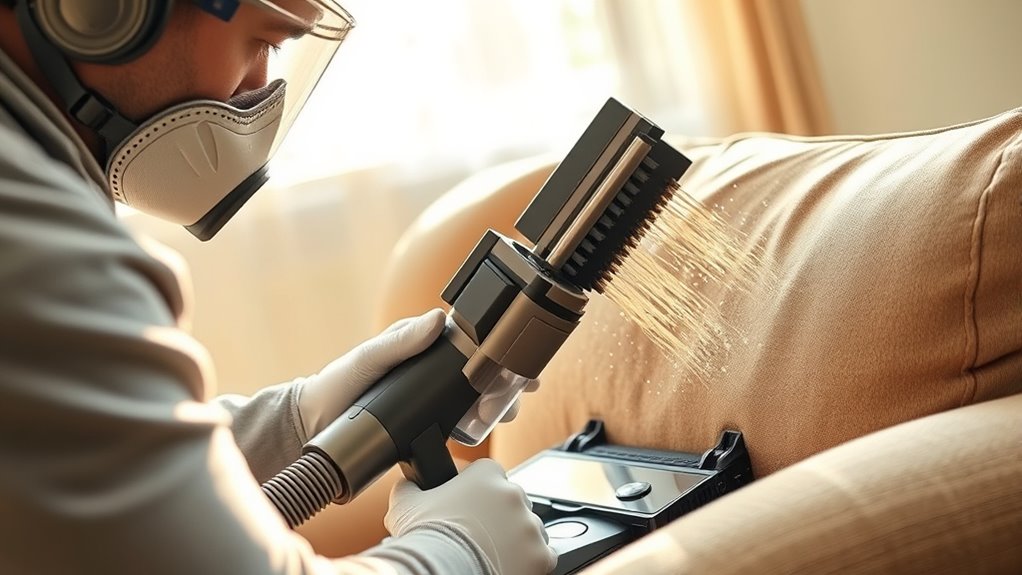
To maximize the benefits of your targeted vacuuming routine, incorporating additional measures can further minimize allergen dispersion. Start by using a vacuum with a HEPA filter, which captures pet hair and dander more effectively. Before vacuuming, groom your pet regularly to reduce shedding and loose hair, decreasing the amount of pet hair removal needed during cleaning. When vacuuming, slow your pace to loosen embedded allergens and debris thoroughly. Use allergen reduction techniques like vacuuming in multiple directions to dislodge trapped pet hair and dander from carpets and upholstery. Additionally, consider wearing a mask for extra protection and emptying your vacuum’s canister immediately after use to prevent allergens from recirculating. These steps help keep allergens contained and improve indoor air quality.
Maintaining Your Vacuum Cleaner for Optimal Performance

Regularly maintaining your vacuum cleaner guarantees it performs at its best, effectively capturing pet hair and allergens. Proper vacuum maintenance involves checking components and replacing parts when needed. Here are four key steps:
- Empty the dustbin or replace the bag regularly to prevent clogs and maintain suction power.
- Clean or replace filters—especially HEPA filters—during filter replacement to keep allergens trapped.
- Inspect the brush roll for hair buildup and remove any obstructions to ensure efficient cleaning.
- Check the vacuum’s hoses and attachments for blockages, ensuring airflow remains unobstructed.
Frequently Asked Questions
How Can I Tell if My Vacuum Is Truly Allergy-Friendly?
To tell if your vacuum is allergy-friendly, check if it has a HEPA filter and make certain you maintain the air filter regularly for peak performance. Look at the cord length considerations—longer cords let you cover more area without switching outlets, reducing dust dispersal. An allergy-friendly vacuum traps pet dander effectively, so keeping filters clean and choosing a model with these features helps minimize flare-ups and keeps your home healthier.
Are There Specific Vacuum Features Best for Pet Allergies?
Imagine a powerful vacuum with a sleek design, its nozzle gripping every pet hair and allergen. You want features like HEPA filters, which trap tiny particles, and strong suction power that pulls allergens from deep within carpets. These elements prevent pet dander from escaping back into the air, making your cleaning more effective. Look for vacuums with high suction and HEPA filtration to create a healthier, allergen-free home environment.
Can Vacuuming Alone Completely Eliminate Pet Allergens?
Vacuuming alone can’t completely eliminate pet allergens, but it considerably reduces them, especially when combined with air purifier integration. For best results, focus on hard floors over carpets since allergens tend to settle into carpets, making them harder to remove. Regular vacuuming with a HEPA filter and using an air purifier can help improve your indoor air quality, minimizing allergy flare-ups.
What Accessories Help Improve Vacuuming Effectiveness for Pet Dander?
To improve your vacuuming effectiveness for pet dander, use accessories like HEPA filters and upholstery tools. HEPA filters trap tiny allergens and prevent them from recirculating in the air, while upholstery tools help lift pet hair and dander from furniture and cushions. These accessories make your cleaning more thorough, reducing allergy flare-ups and creating a healthier environment for you and your pets.
How Do I Handle Vacuuming in Multi-Pet Households?
Handling vacuuming in multi-pet households is like steering a ship through choppy waters. Focus on pet hair management by vacuuming frequently with a HEPA filter to trap allergens effectively. Use attachments to reach tight spaces and guarantee allergen containment. Regularly empty the vacuum to prevent buildup. This proactive approach keeps pet dander at bay, creating a cleaner, healthier environment where everyone can breathe easier and enjoy the space.
Conclusion
By following these vacuuming tips, you’ll turn your home into a fortress against pet allergens. Think of your vacuum as a loyal guardian, tirelessly working to keep sneezes and itchy eyes at bay. Regular, proper vacuuming isn’t just maintenance—it’s your secret weapon to breathe easier and enjoy your space more. With a little effort, you’ll create a healthier haven where pet love doesn’t have to come with allergy flare-ups.

